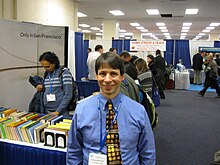|
Arthur T. Benjamin
Arthur T. Benjamin (born March 19, 1961) is an American mathematician who specializes in combinatorics. Since 1989, he has been a professor of mathematics at Harvey Mudd College, where he is the Smallwood Family Professor of Mathematics.[1] He is known for mental math capabilities and "Mathemagics" performances in front of live audiences. His mathematical abilities have been highlighted in newspaper and magazine articles, at TED Talks and on the Colbert Report. EducationBenjamin earned a Bachelor of Science with highest honors in applied mathematics at Carnegie Mellon University in 1983. He then went on to receive a Master of Science in Engineering in 1985 and a Doctor of Philosophy in 1989 in mathematical sciences at Johns Hopkins University. His PhD dissertation was titled "Turnpike Structures for Optimal Maneuvers", and was supervised by Alan J. Goldman.[2] During his freshman year at CMU, he wrote the lyrics and created the magic effects for the musical comedy, Kije!, in collaboration with author Scott McGregor and composer Arthur Darrell Turner. This musical was the winner of an annual competition and was first performed as the CMU's Spring Musical in 1980.[3] CareerAcademic Benjamin held several mathematics positions while attending university, including stints with the National Bureau of Standards, the National Security Agency, and the Institute for Defense Analyses. Upon receipt of his PhD, he was hired as an assistant professor of mathematics at Harvey Mudd College. He is currently a full professor at Harvey Mudd and was chair of the mathematics department from 2002 to 2004. He has published over 90 academic papers and five books.[2] He has also filmed several sets of lectures on mathematical topics for The Great Courses series from The Teaching Company, including a course on Discrete Mathematics, Mental Math, and The Mathematics of Games and Puzzles: From Cards to Sudoku. He served as co-editor of Math Horizons magazine for five years.[4] Mathemagics Benjamin has long had an interest in magic. While in college, he honed his skills as a magician and attended magic conferences. At one of these conferences, he met well-known magician and skeptic James Randi, who greatly influenced Benjamin's decision to perform Mathemagics shows for live audiences. Randi invited him to perform his mathematical tricks on a television program called Exploring Psychic Powers Live, co-hosted by Uri Geller. Randi also encouraged Benjamin to become involved in the growing skeptical movement. He attended early meetings of the Southern California Skeptics in the 1990s, which later evolved into the Skeptics Society. It was at these meetings that he met Skeptics Society President Michael Shermer, who would later become a co-author on three of Benjamin's books.[5] Benjamin regularly performs his Mathemagics program for live audiences at schools, colleges, conferences, and even at The Magic Castle in Hollywood, California.[6] These shows feature Benjamin performing mathematical feats like rapidly squaring numbers with up to five digits and correctly identifying the day of the week on which audience members were born based on their birth dates.[7] He was also featured in Mathemagics, a multimedia disc released for the 3DO Interactive Multiplayer in 1994, which consists largely of short demonstrations and lessons by Benjamin in mental math and Mathemagics.[8]  Awards and honors
MediaBenjamin has appeared in three TED Talks. The first, in 2005, was a demonstration of his Mathemagics show. The second, in 2009, was a plea for improved math education in schools. The third, in 2013, was about the way the Fibonacci series of numbers provides an excellent example of the three most important reasons for studying mathematics: Calculation, Application, and Inspiration.[11] Benjamin hosted lectures in The Great Courses titled The Joy of Mathematics and Secrets of Mental Math.[12] He has appeared on numerous television programs throughout the years, including a notable performance on the Colbert Report in 2010. He has been profiled in over 100 articles in periodicals such as The New York Times, People Magazine, USA Today, and Scientific American.[13] Bibliography
See alsoReferences
External links |
||||||||||||||||||||
